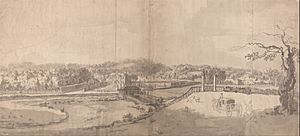Esholt Priory facts for kids
| Monastery information | |
|---|---|
| Order | Cistercian |
| Established | 12th Century |
| Disestablished | 1540 |
| Mother house | Syningthwaite Priory |
| Diocese | Diocese of York |
| People | |
| Founder(s) | Simon Warde |
| Site | |
| Location | Esholt |
| Visible remains | None |
| Esholt Hall | |
|---|---|

18th century painting of Esholt Hall in the grounds of the former priory
|
|
| Type | Private Residence |
| Location | Esholt, West Yorkshire |
| Built | 1706–7 |
| Architectural style(s) | Queen Anne Style |
| Governing body | Privately owned |
|
Listed Building – Grade II*
|
|
| Official name: Esholt Priory | |
| Designated | 4 September 1952 |
| Reference no. | 1133190 |
Esholt Priory was a special place in West Yorkshire, England, where a group of Cistercian nuns lived and prayed. A priory is like a monastery for nuns. This priory was later closed down, and a grand house called Esholt Hall was built where it once stood. Today, Esholt Hall is a very important historic building.
Contents
Esholt Priory: A Look Back
How it Started
Esholt Priory was built a long time ago, in the 1100s. A man named Simon Warde gave the land for the priory. His son later confirmed this gift in 1172 and again in 1185. The priory was dedicated to two saints, St Mary and St Leonard. It was a home for nuns who followed the Cistercian way of life.
Priory Life and Changes
Life at the priory continued for many years. However, in 1303, the leader of the nuns, called the Prioress Juliana De La Wodehall, tried to resign. She wanted to step down because of some difficulties within the priory. But the bishop, who was a church leader, did not accept her resignation.
The priory eventually closed in 1540. This happened during a time in England called the Dissolution of the Monasteries. This was when King Henry VIII decided to close down many monasteries and priories across the country. Their lands and wealth were then taken by the Crown.
Esholt Hall: A New Beginning
Building the Hall
After Esholt Priory was closed, its land was given to a man named Henry Thompson. His daughter, Frances Thompson, later married Walter Calverley. Their son, Sir Walter Calverley, 1st Baronet, decided to build a new house on the site of the old priory.
He started building Esholt Hall in 1706 and finished it in 1707. The house was designed in the Queen Anne style. This was a popular way of building houses at that time, known for its balanced and elegant look.
Who Lived There?
Sir Walter Calverley's son, Sir Walter Calverley-Blackett, later sold Esholt Hall in 1755. It was bought by Robert Stansfield from Bradford.
After Robert Stansfield, the hall was passed down through his family. His niece, Anna Maria Rookes, and her husband Joshua Crompton, became the owners. Their son, William Crompton-Stansfield, was an important person who became a Member of Parliament (MP). An MP is someone elected to represent people in the country's government.
When William Crompton-Stansfield passed away in 1871, his nephew, General William Henry Crompton-Stansfield, inherited the estate. Esholt Hall remains a privately owned home today. It is also a Grade II* listed building, which means it's a very important historical building that is protected.

